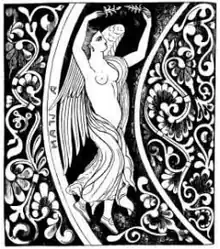Albina, also known as Albine or The White Goddess,[1] is a goddess (possibly Etruscan) associated with the dawn and the founding of Great Britain. She is first mentioned in the Anglo-Norman poem Des Grantz Geanz.[2]

"Des Grantz Geanz"
The first mention of Albina is in the Anglo-Norman poem Des Grantz Geanz, which dates to the late 13th or early 14th century, and has been tentatively dated no later than 1333.[3] An abridged form of the poem was appended as a prologue to the Brut Chronicle.[4]
In the poem, Albina is the eldest of 30 daughters of a Greek king. The daughters resent the subjugation of marriage and conspire to murder their husbands, but the youngest confesses to the conspiracy before they can act. When their father learns of their plot, the twenty-nine unrepentant sisters are exiled from Greece and arrive at an uninhabited island, which they name Albion after Albina. There, they are seduced by incubi and give birth to a race of giants. These giants are identified as the ones that Brutus encounters when he arrives at Britain in Geoffrey of Monmouth's Historia Regum Britanniae.[2]
An alternate version of the poem has Albina and her sisters as daughters of King Diodicias of Syria. In this version, the conspiracy is not revealed in advance and the sisters are exiled after successfully killing their husbands.[5]
"The White Goddess"
Robert Graves' essay "The White Goddess" describes Albina as of one of fifty sisters (see Danaïdes) who named Albion.[6] It is thought that the original name for Great Britain, Albion, was inspired by the White Cliffs of Dover, derived from the Latin albus, meaning "white" or "bright".
"Etruscan Roman Remains in Popular Tradition"
Albina is mentioned in Charles Godfrey Leland's 1892 collection of folklore "Etruscan Roman Remains in Popular Tradition". According to Leland, Albina was an Etruscan goddess of light and ill-fated lovers. The accounts of Albina were obtained by word of mouth from local and often illiterate peasants, some of whom were considered witches or "Strega".[7] Possibly a combination of other deities such as Alpanu and Aurora, Albina is described as a beautiful flying woman (or fairy) and associated with light. The Albina referenced by Leland is likely only loosely related to the figure described in The White Goddess.
References
- ↑ Graves, Robert (1948). The White Goddess (16th ed.). p. 68.
- 1 2 Brereton 1937, p. v.
- ↑ Brereton 1937, p. xxxiii.
- ↑ Brereton 1937, p. xxxvii.
- ↑ Brereton 1937, p. xxxv.
- ↑ de Wavrin, John (1864). A Collection of Chronicles and ancient Histories of Great Britain. p. 29.
- ↑ Leland, Charles Godfrey (1892). Etruscan Roman Remains in Popular Tradition. p. 5.
- Brereton, Georgine E (1937). Des Grantz Geanz: An Anglo-Norman Poem. Oxford, UK: Basil Blackwell. Retrieved 6 December 2023.
- Leland, Charles Godfrey. Etruscan Roman Remains in Popular Tradition. p. 124.
- Graves, Robert. The White Goddess: A Historical Grammar of Poetic Myth. pp. 67–8.
- de Wavrin, John. A Collection of the Chronicles and ancient Histories of Great Britain, now called England. p. 29.
External links
- "[no title cited]" (PDF). aren.org. Wicca. Archived from the original (PDF) on 2015-09-23.
- "Glossary entries A-C". moonlitdesign.com. An incomplete glossary to Robert Graves' The White Goddess a historical grammar of poetic myth.
- de Wavrin, John (1864). A Collection of the Chronicles and ancient Histories of Great Britain, now called England, by John de Wavrin, translated by Will. Hardy: From Albina to A.D. 688. Translated by Hardy, Will – via Google Books.